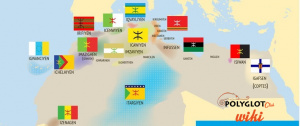Language/Kabyle/Culture/Traditional-clothing
Traditional clothing is an important aspect of Kabyle culture. It represents the history, heritage, and identity of Kabyle people. Kabyle clothing is unique, colorful, and symbolizes different meanings. In this lesson, we will learn about traditional clothing in Kabyle culture, its significance, and when it is worn.
Consider exploring these related pages after completing this lesson: Traditional music & Berber dialects.
History and Significance
Traditional Kabyle clothing traces its origin back to the ancient times of the Berber civilization. Clothing was used as a means of artistic expression and symbolized the wearer's social status, religion, and region. The designs, colors, and materials used in traditional clothes vary depending on the region.
Traditional clothing is still worn on special occasions, including weddings, religious events, and traditional festivals. Wearing traditional clothing is a way for Kabyle people to honor their ancestors and preserve their cultural identity.
Traditional Men's Clothing
Men's traditional Kabyle clothing consists of a woolen robe known as a Djellaba and a head covering called a tagelmust. The Djellaba is usually made from wool, and colors range from white to dark brown. The sleeves are long and wide, with a hood that can be drawn up in cold weather. Men wear the Djellaba over their normal clothes.
The tagelmust is a long piece of cloth that is wrapped around the head and face, leaving only the eyes exposed. It serves as protection from the harsh desert sun and sand. The color of the tagelmust varies depending on the region and social status of the wearer.
Men also wear leather slippers called Balghas. They are soft, comfortable, and protect the feet from the rocky ground. Balghas are available in various colours, and the quality of leather and design varies depending on the region.
Traditional Women's Clothing
Women's traditional Kabyle clothing consists of a long dress called a Takchita or Amelkis, headscarf, and jewelry. The Takchita is made of silk or wool, and the colors and designs vary depending on the region. The dress is long, flowing, and has long sleeves. It is usually brightly colored and has intricate embroidery, sequins, or beadwork.
Women also wear a headscarf known as a Loukmane. It is a long, rectangular piece of cloth that is wrapped around the head and tied at the nape of the neck. The Loukmane is usually brightly colored and has intricate embroidery or beadwork.
Women also wear various types of jewelry, including necklaces, bracelets, and earrings. The jewelry is usually made of silver and decorated with amber, coral, or turquoise stones. The jewelry complements the brightly colored dress and enhances the beauty of the wearer.
Traditional Children's Clothing
Traditional Kabyle children's clothing varies based on gender, but they usually wear clothing that is similar to adult clothing. Girls wear a smaller version of Takchita, and boys wear Djellaba like their fathers. The clothing is often brightly colored and decorated with embroidery, sequins, or beadwork.
Conclusion
In a nutshell, traditional Kabyle clothing is an integral part of Kabyle culture. It symbolizes the history, heritage, and identity of Kabyle people. Traditional clothing is still worn on special occasions, including weddings, religious events, and traditional festivals. The designs, colors, and materials used in traditional clothes vary depending on the region.
Kabyle people take pride in their traditional clothing and wear it with dignity and respect. Preserving traditional clothing is a way to honor their ancestors and pass on their cultural heritage to future generations.
Well done on mastering this lesson! Don't miss these related pages to expand your knowledge: Traditional dance & Holidays and celebrations.
Videos
Algerian traditional dance kabyle - YouTube
Other Lessons

